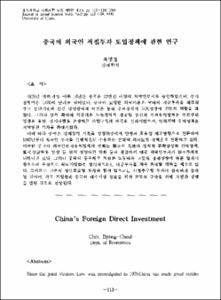보강토 옹벽의 신뢰도 해석
- Alternative Title
- Reliability Analysis on Reinforced Walls
- Abstract
- 일반적으로 옹벽의 설계는 설계자의 주관적 판단에 좌우되므로, 전통적인 설계방법은 설계과정을 수치적으로 일반화하기가 곤란할 뿐만 아니라 최종적인 설계 단면이 가장 적합한 것이라고 확신 할 수 없다. 사용재료의 물성치에 내포되어있는 불확실성을 표현할 수 없음은 물론 불안정상태에서 발휘되고 있는 설계변수의 값이 얼마인가를 명확히 표현할 수 있는 물리적 근거가 모호하다. 특히 보강토 옹벽읙 경우에는 토성치뿐만 아니라 흙/보강재 사이의 불확실성까지 고려되어져야 한다. 본 논문에서는 보강토 옹벽에 적용된 토성치와 흙/보강재 상호매개변수의 불확실성이 안정해석에 얼마나 영향을 미치는지를 확률적인 방법을 이용한 신뢰도 해석을 수행하였다.
신뢰도 해석을 수행한 결과, 흙/보강재 사이의 접속마찰각 δ의 변화가 파괴확률 pf에 가장 큰 영향을 미치는 것으로 나타났다. 보강토체내 뒤채움흙 단위중량 γr 및 보강재 길이 L의 경우 CV값이 20%가 될때 일정 한계치보다 작은 값을 가지면 파괴확률 pf가 급격하게 증가함을 보였으며 배면토제 단위중량 γf은 파괴확률 pf에 큰 영향을 끼치지 못하는 것으로 나타났다.
Traditionally, the reliability of retaining walls is achieved through the use of safety factors or margins and adopting conservative assumption in the process of design.
However, that is often defined on the basis of subjective judgements. such a traditional design methods are difficult to quantify and lack the logical basis of describing uncertainty. expecially, reingorced walls consider not only soil properties but soil-reinforcement interaction uncertaintees.
This paper described how probabilistic description of soil parameters and soil-reinforcement interaction parameters were applied to the stability analysis. The first-order, second moment approach was explored and applied tot he design of reinforced walls. an example illustrated the relative contribution of uncertainties about different parameters to the reliability of the reinforced walls.
The results obtained from this study were follows; the reliability of the soil-reinforcement interface friction angle, δwas highly sensitive to the coefficient of variation.
However, whenthe backfill soil unit weight, γr and the reinforcement length, L were lower than the limited values, the probabilities of failure were increased.
The reliability of the soil unit weight, γf in the unreinforced area was lowly sensitive to the coefficient of variation.
Traditionally, the reliability of retaining walls is achieved through the use of safety factors or margins and adopting conservative assumption in the process of design.
However, that is often defined on the basis of subjective judgements. such a traditional design methods are difficult to quantify and lack the logical basis of describing uncertainty. expecially, reingorced walls consider not only soil properties but soil-reinforcement interaction uncertaintees.
This paper described how probabilistic description of soil parameters and soil-reinforcement interaction parameters were applied to the stability analysis. The first-order, second moment approach was explored and applied tot he design of reinforced walls. an example illustrated the relative contribution of uncertainties about different parameters to the reliability of the reinforced walls.
The results obtained from this study were follows; the reliability of the soil-reinforcement interface friction angle, δwas highly sensitive to the coefficient of variation.
However, whenthe backfill soil unit weight, γr and the reinforcement length, L were lower than the limited values, the probabilities of failure were increased.
The reliability of the soil unit weight, γf in the unreinforced area was lowly sensitive to the coefficient of variation.
- Issued Date
- 2000
- Type
- Research Laboratory
- Alternative Author(s)
- Min,Tuk-ki; Kim,Kyoung-min
- Publisher
- 공학연구논문집
- Language
- kor
- Rights
- 울산대학교 저작물은 저작권에 의해 보호받습니다.
- Citation Volume
- 31
- Citation Number
- 1
- Citation Start Page
- 271
- Citation End Page
- 279
- Appears in Collections:
- Research Laboratory > Engineering Research
- 파일 목록
-
-
Download
 000002024794.pdf
기타 데이터 / 968.53 kB / Adobe PDF
000002024794.pdf
기타 데이터 / 968.53 kB / Adobe PDF
-
Items in Repository are protected by copyright, with all rights reserved, unless otherwise indicated.